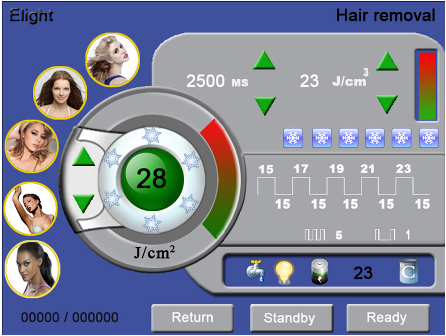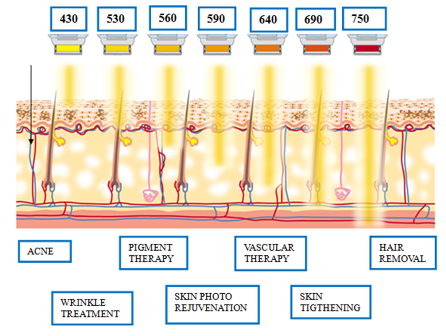Hair Removal with I.P.L o (Intense Pulsed Light)
Intense Pulsed Light (IPL) is a kind of high-intensity source of broadband coherent light these properties allow IPL to have wide application for ablative resurfacing therapy, which is based on the theory of selective absorption of human skin tissue and photo thermolysis light sources.
Meanwhile, IPL photorejuvenation technology is more efficient and offers patients less downtime than conventional therapies for aged and photodamaged skin.

IPL uses special filters that block unwanted wavelengths. The filters can be changed to “cut off” the shorter wavelengths.
The appropriate filter will depend on the depth of the intended target IPL systems work on the same principles as lasers in that light energy is absorbed into particular target cells with color (chromophores) in the skin having the wavelength range of 500 nm- at 1200 nm.


The light energy is converted to heat energy, which causes a specific result to the target area.
IPL systems are different from lasers in that they deliver many wavelengths (or colors) in each pulse of light instead of just one wavelength. Most IPL systems use filters to refine the energy output for the treatment of certain areas. This enhances penetration without using excessive energy levels and enables the targeting of specific chromophores (these are skin components that absorb light).
IPL therapy is considered a non-ablative resurfacing technique, which means that it targets the lower layers of skin (dermis) without affecting the top layers of skin (epidermis).
The advantage of IPL therapy is its minimal downtime – a patient can often have the procedure done in their lunch break and return to work immediately afterward.
With the IPL equipment, you can perform treatments from acne, pigment therapy (dark spots), varicose veins, hair removal, wrinkle treatments, skin photorejuvenation, and skin tightening. WHAT is Intense Pulsed Light or IPL? Intense Pulsed Light (IPL) is a kind of high-intensity source of broadband coherent light These properties allow IPL to have wide application for ablative resurfacing therapy, which is based on the theory of selective absorption of human skin tissue and photo thermolysis light sources. Meanwhile, IPL photorejuvenation technology is more efficient and offers patients less downtime than conventional therapies for aged and photodamaged skin.

IPL uses special filters that block unwanted wavelengths. The filters can be changed to “cut off” the shorter wavelengths.
The appropriate filter will depend on the depth of the intended target

IPL systems work on the same principles as lasers in that light energy is absorbed into particular target cells with color (chromophores) in the skin having the wavelength range of 500 nm- at 1200 nm.
The light energy is converted to heat energy, which causes a specific result to the target area. IPL systems are different from lasers in that they deliver many wavelengths (or colors) in each pulse of light instead of just one wavelength.
Most IPL systems use filters to refine the energy output for the treatment of certain areas. This enhances penetration without using excessive energy levels and enables the targeting of specific chromophores (these are skin components that absorb light).
IPL therapy is considered a non-ablative resurfacing technique, which means that it targets the lower layers of skin (dermis) without affecting the top layers of skin (epidermis).
The advantage of IPL therapy is its minimal downtime – a patient can often have the procedure done in their lunch break and return to work immediately afterward.

With the IPL equipment, you can perform treatments from:
Acne,
Pigment therapy (dark spots),
Varicose veins,
Hair removal,
Wrinkle treatments,
Skin photorejuvenation, and
Skin tightening.
Hair removal may be used for hair in any location including underarms, bikini line, face, neck, back, chest, and legs.
For the treatment of unwanted hair. Light pulses targeted at the hair follicle causing the hair to fall out and prevent further growth. Generally ineffective for light-colored hair.
Pigment therapy, photo rejuvenation: The treatment itself works much like a laser, but instead of having just one wavelength of light, the machine produces a spectrum of light made up of a range of wavelengths.
By selecting an appropriate filter, the trained skincare professional selects the wavelength range to target the damaged area caused by skin aging and sun exposure.
Some fine lines, superficial wrinkles, and texture of the skin may be addressed
More information:
http://en.wikipedia.org/wiki/Intense_pulsed_light










 En BlasonOnline encontraras todo lo que necesitas para tu Estética o SPA. Ubicados en Miami, Florida, exportamos equipos y muebles para Spas, equipos de Estetica multifunciones para faciales, perdida de peso, microdermabrasion y otros suministros hacia Norte America,Centro-America,Sur-America y El Caribe. Ofrecemos entrega inmediata y a bajo precio sin intermediarios ni comisiones. No dude en visitar nuestro Salon de exposiciones donde podra apreciar y comprobar la calidad de nuestros equipos para Spas y Salas de Estetica.
En BlasonOnline encontraras todo lo que necesitas para tu Estética o SPA. Ubicados en Miami, Florida, exportamos equipos y muebles para Spas, equipos de Estetica multifunciones para faciales, perdida de peso, microdermabrasion y otros suministros hacia Norte America,Centro-America,Sur-America y El Caribe. Ofrecemos entrega inmediata y a bajo precio sin intermediarios ni comisiones. No dude en visitar nuestro Salon de exposiciones donde podra apreciar y comprobar la calidad de nuestros equipos para Spas y Salas de Estetica.













